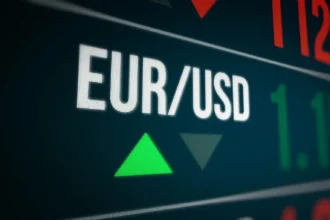The U.S. dollar plunged to decade-lows on Friday, shaking investor confidence and altering the global currency landscape. The catalyst? Escalating trade tensions and a lack of clarity from the Trump administration regarding tariff policy. As global markets reel from volatile reactions, the dollar’s role as a safe haven is being questioned like never before.
Dollar Downturn: The Stats Behind the Slide
The dollar index, which benchmarks the greenback against a basket of major currencies, fell as much as 1.2%, briefly dipping below the 100 mark for the first time since July 2023. Against the Swiss franc, it dropped to 0.81150—a level not seen since January 2015. Versus the euro, the dollar lost 1.14%, while the Japanese yen strengthened by 1.4%.
FX strategist Francesco Pesole from ING described it bluntly: “This isn’t just dollar deleveraging anymore. It’s a full-blown dollar crisis.”
Trade War Fallout: The Tariff Escalation That Shook Markets
China announced it would raise tariffs on U.S. goods from 84% to 125%, beginning Saturday. The decision came in direct response to earlier U.S. tariffs imposed as part of President Trump’s ongoing “reciprocal trade policy.” While Treasury Secretary Scott Bessent suggested that tariffs could soften after diplomatic discussions, markets found little reassurance.
Despite a brief pause in new tariffs against some U.S. allies, Trump doubled down on duties for Chinese imports, signaling that he’s factoring in market turmoil into his broader policy stance.
Safe Havens Surge: Franc, Yen, and Gold Shine
Traditionally seen as safe havens, the Swiss franc and Japanese yen surged as investors exited U.S. assets. The dollar’s freefall has led to significant appreciation in these currencies. The Swiss National Bank (SNB) remained tight-lipped, but analysts believe it’s a tough situation for the central bank, especially given the deflationary impact of a stronger franc.
“The SNB likely wants to intervene, but conditions make it hard to do so on a meaningful scale,” said Michael Pfister of Commerzbank.
🇪🇺 The Euro’s Ascendancy
The euro was one of the biggest gainers, rising 2.5% at its peak to hit a three-year high against the dollar. It also strengthened against the British pound. European Central Bank (ECB) President Christine Lagarde assured markets that the ECB stands ready to maintain financial stability through robust policy tools.
This vote of confidence supported the euro’s momentum, especially as the U.S. dollar struggled amid growing uncertainty around domestic economic policy and global diplomacy.
🇨🇳 Yuan: Caught in the Crossfire
The Chinese yuan experienced volatility, falling sharply against the euro and briefly hitting a record low against the dollar earlier in the week. Although it rebounded slightly, the yuan remains under pressure amid ongoing geopolitical and economic uncertainty.
China’s aggressive response to U.S. tariffs further complicates the currency outlook, as investors assess the possibility of capital controls or central bank intervention.
What’s Driving This Crisis of Confidence?
Investor sentiment has shifted from cautious optimism to outright skepticism about U.S. policy consistency. Comments from Nomura strategist Naka Matsuzawa summed it up: “It’s a no-confidence vote—not just from equity traders but also bond market participants.”
The abrupt changes in U.S. policy have created unpredictable conditions that undermine the dollar’s long-standing role as the global reserve currency.
Implications for Forex Traders and Global Markets
- Short-Term Volatility: Expect significant swings in currency pairs, particularly USD/CHF, USD/JPY, EUR/USD, and USD/CNY.
- Central Bank Action: Both the SNB and ECB may step in if volatility persists, either through direct intervention or policy signaling.
- Long-Term Realignment: The dollar’s decline could trigger a shift in global reserves diversification, with central banks favoring the euro, yen, or gold-backed assets.
What’s Next? Projections Through 2025
While some analysts view the current downturn as a temporary reaction to trade policy, others believe we’re seeing the start of a broader de-dollarization trend.
Short-Term Forecast (Q2–Q4 2025):
- USD/CHF: Projected to hover around 0.8100–0.8300
- EUR/USD: Could climb to $1.15 if ECB maintains its stance and U.S. uncertainty continues
- USD/JPY: Range-bound between 141.00 and 144.00
- USD/CNY: May stabilize near 7.30 if PBOC intervenes
Long-Term Outlook:
Unless U.S. policy becomes more predictable, the dollar may struggle to regain its traditional stronghold. Forex traders should consider rebalancing portfolios, emphasizing emerging safe-haven assets.
❓ FAQ: Dollar Decline and Market Volatility
Q1: Why is the U.S. dollar falling?
The dollar is declining due to escalating trade tensions, inconsistent U.S. policy messaging, and growing global investor skepticism.
Q2: Is this a short-term dip or a long-term trend?
While short-term rebounds are possible, current trends suggest a structural shift that could pressure the dollar for years.
Q3: What currencies are gaining against the dollar?
The Swiss franc, euro, and Japanese yen have all strengthened significantly, benefiting from their safe-haven status.
Q4: Will central banks intervene?
Yes, particularly the SNB and PBOC may act to stabilize their currencies if volatility escalates further.
Q5: How should forex traders respond?
Traders should hedge USD exposure, focus on diversification, and monitor central bank signals closely.
⚠️ Disclaimer
This article is for informational purposes only and does not constitute investment advice. Currency trading involves significant risk and may not be suitable for all investors. Always consult with a qualified financial advisor before making trading decisions.



